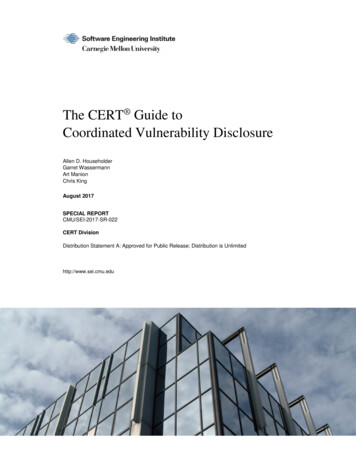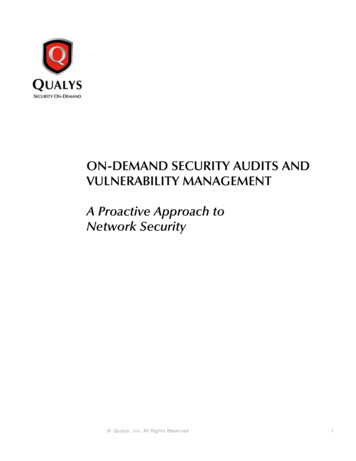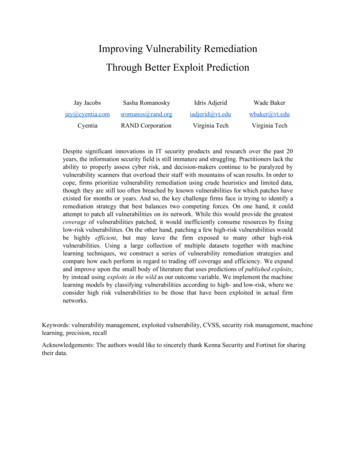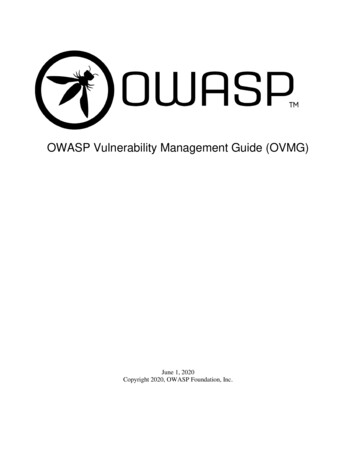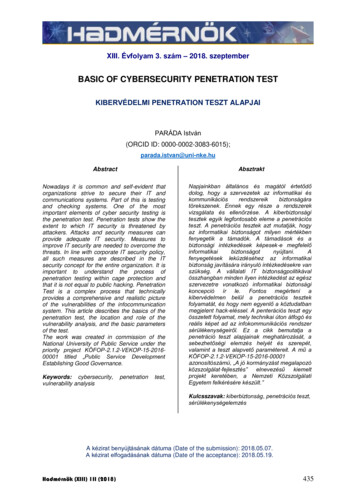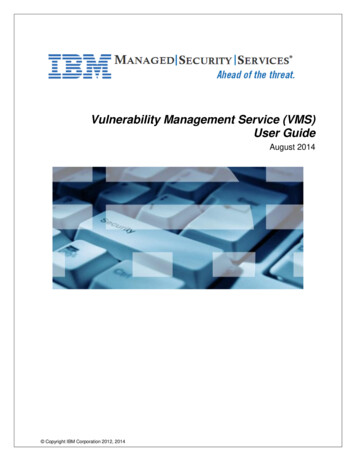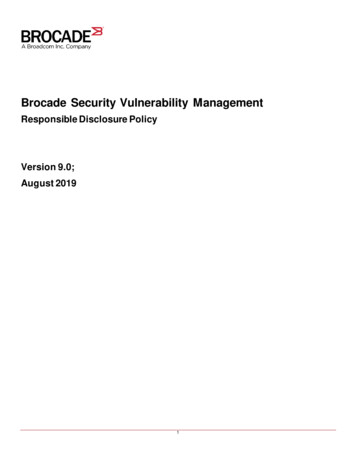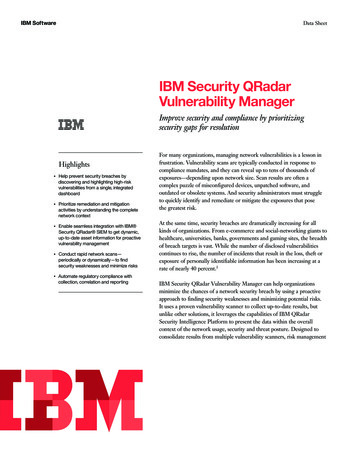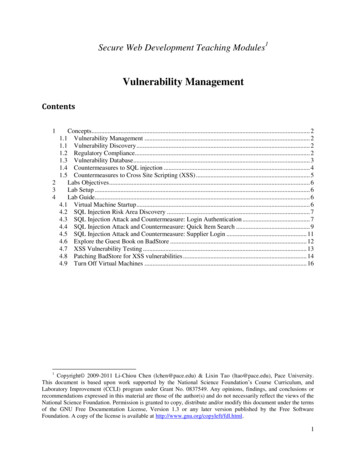
Transcription
Secure Web Development Teaching Modules1Vulnerability ManagementContents1Concepts. 2Vulnerability Management . 2Vulnerability Discovery . 2Regulatory Compliance. 2Vulnerability Database. 3Countermeasures to SQL injection . 4Countermeasures to Cross Site Scripting (XSS) . 52Labs Objectives . 63Lab Setup . 64Lab Guide. 64.1 Virtual Machine Startup . 64.2 SQL Injection Risk Area Discovery . 74.3 SQL Injection Attack and Countermeasure: Login Authentication . 74.4 SQL Injection Attack and Countermeasure: Quick Item Search . 94.5 SQL Injection Attack and Countermeasure: Supplier Login . 114.6 Explore the Guest Book on BadStore . 124.7 XSS Vulnerability Testing . 134.8 Patching BadStore for XSS vulnerabilities . 144.9 Turn Off Virtual Machines . 161.11.11.21.31.41.51Copyright 2009-2011 Li-Chiou Chen (lchen@pace.edu) & Lixin Tao (ltao@pace.edu), Pace University.This document is based upon work supported by the National Science Foundation‟s Course Curriculum, andLaboratory Improvement (CCLI) program under Grant No. 0837549. Any opinions, findings, and conclusions orrecommendations expressed in this material are those of the author(s) and do not necessarily reflect the views of theNational Science Foundation. Permission is granted to copy, distribute and/or modify this document under the termsof the GNU Free Documentation License, Version 1.3 or any later version published by the Free SoftwareFoundation. A copy of the license is available at http://www.gnu.org/copyleft/fdl.html.1
1 Concepts1.1Vulnerability ManagementVulnerabilities are flaws (or bugs) in operating systems, software applications, or networkingprotocols that can be exploited by adversaries to obtain access or elevate access privilege of the computersystems. Vulnerability management is a security practice by which organizations set up procedures todiscover vulnerabilities in its systems/applications and to fix the vulnerabilities proactively before beingexploited2.Patches are additional program added to the original software or systems to address thevulnerabilities. Like bandages, patches fix vulnerabilities or reduce the impact of the vulnerabilities onceexploited. Applying patches timely is critical since attackers these days usually exploit vulnerabilitiessoon after they are discovered. Hence, automatic vulnerability scanning and a standard patch managementprocess enable the risk of vulnerable systems/applications.1.1Vulnerability DiscoveryVulnerability scanning is a process of searching for known vulnerabilities in software or computersystems. The scanning can be focused on different aspects of a computer system. For example, portscanning searches for opening ports on a computer system and web application scanning searches forvulnerabilities in web applications/services. Vulnerability scanner such as Nessus looks for vulnerabilitiesin a computer system against a list of known vulnerabilities, which are mostly well documented in publicaccessible vulnerability databases.Web vulnerability scanning focuses on discovering vulnerabilities in a web application/service.Instead of checking for a broad range of software or system vulnerabilities, web vulnerability scanners,different from general vulnerability scanners, check for vulnerabilities embedded in a web applicationsuch as testing invalid form inputs or exploiting cookies. Both OWASP3 and WASC4 web sites maintain alist of web vulnerability scanners. The Web Application Vulnerability Scanner Evaluation Project(WAVSEP)5 develops a set of test cases for benchmarking web vulnerability scanners.1.2Regulatory ComplianceRegulatory compliance often is a driver of vulnerability management program in both privatecorporations and government agencies. To be compliant to regulations, corporations will need tools toautomate the process of vulnerability discovery and management so that they can address the regulatedsecurity controls. Under the Federal Information Security Management Act (FISMA), the U.S. federalagencies have to be compliant to various security controls for operation and management. In addition, theFederal Desktop Core Configuration (FDCC) has extensive requirements for federal agencies in terms ofdesktop and laptop PCs that run on Microsoft Windows. The National Institute of Standard andTechnology (NIST) has developed SCAP (the Security Content Automation Protocol)6 to standardize the2Peter Mell. Tiffany Bergeron and David Henning. “Creating a Patch and Vulnerability ManagementProgram,” NIST Special Publication 800-40, Version 2.0, November David Waltermire, Stephen Quinn and Karen Scarfone. “The Technical Specification for the Security ContentAutomation Protocol (SCAP): SCAP Version 1.1,” NIST Special Publication 800-126 Revision 1, February 2011.2
format that security software communicates vulnerabilities and security configuration. Although it cannotaddress issues in FISMA entirely, SCAP provides capabilities to conduct security checks in controlsrequired by both FISMA and FDCC. Various security vendors have provided SCAP-compatible productsto meet this demand7.SCAP is a suite of specifications consisted of six components including8 Common Vulnerabilities and Exposures (CVE): a standard for numbering and listingknown software vulnerabilities.Common Configuration Enumeration (CCE): a standard for identifying securityparameters in the configuration of operating systems and software applications.Common Platform Enumeration (CPE): a structured naming scheme for informationtechnology systems, platforms, and packages.Common Vulnerability Scoring System (CVSS): an open framework forcommunicating the characteristics and impacts of IT vulnerabilities. CVSS quantifiesthe risk imposed by vulnerabilities.Extensible Configuration Checklist Description Format (XCCDF): is a specificationlanguage based on XML for writing security checklists, benchmarks, and relatedkinds of documents.Open Vulnerability and Assessment Language (OVAL): an international, informationsecurity, community standard to promote open and publicly available securitycontent, and to standardize the transfer of this information across the entire spectrumof security tools and services. OVAL, based on XML, includes a language to encodesystem details, and an assortment of content repositories held throughout theinformation security community.1.3Vulnerability DatabaseVulnerability databases provide a list of known vulnerabilities and their description in details. Thesedatabases include vendor owned databases, such as X-Force database and VUPEN security advisories,community databases, such as the Exploit Database, Open Source Vulnerability Database (OSVDB) andBugtraq, and the government maintained databases, such as the National Vulnerability Database (NVD).NVD9 is the U.S. government repository of standards based vulnerability management data, whichenables automation of vulnerability management, security measurement, and compliance. Allvulnerabilities represented using SCAP.Web application vulnerabilities as other software vulnerabilities are also included in general purposevulnerability database such as NVD or OSVDB. OWASP maintains a list of top ten web applicationvulnerabilities10 to highlight the prevalence of vulnerabilities in web applications from scapproducts.cfm.Steve H. Weingart. “Using SCAP to Detect Vulnerabilities,” atsec information security corporation, index.php/Category:OWASP Top Ten Project83
1.4Countermeasures to SQL injectionOnce vulnerabilities are discovered in software applications, patches have to be applied to remove oravoid the vulnerabilities. This module will discuss examples of countermeasures against two commonweb application vulnerabilities: SQL injection and Cross-Site Scripting (XSS).SQL injection is caused by insufficient input validations. Web vulnerability scanners should be ableto spot some of the potential risk raised by SQL injections. A proactive countermeasure is to have safecoding practice11, which include Input type checking: developers can filter for invalid input types; Encoding of inputs: developers should use functions provided by the programming languageor the database APIs to encode inputs so that the invalid inputs will not be considered asdatabase meta-characters; Positive pattern matching: developers check for valid input types if checking for negatives arehard to achieve; and Identification of all input sources: all input sources are subject to checking.In our lab exercises, we will examine the SQL injection vulnerabilities in Badstore.net, in which thedatabase queries are handled in Perl. To sanitize inputs, Perl uses two methods to handle dynamic SQLqueries: quote() and bind param()12. The purpose of quote() method is to put a pair of quotation marks onthe input variables so that any special character in the inputs will be treated as inputs, not part of the SQLmeta-characters. For example, in the SQL command below, a quote() method should be applied on thevariable to prevent invalid inputs.SELECT * FROM mysql.customer WHERE name ' username';To prepare for database inputs, the Perl scripts need to sanitize the variable username as below.my Username "Lisa O’Conners";### dbh is the database handlemy quotedUsername dbh- quote( Username );my sth dbh- prepare( "SELECT * FROM mysql.customer WHERE name quotedUsername" ); sth- execute();exit;In Perl, parameters, also called binding or placeholders, are the variables that hold inputs. Tosanitize parameters, you will need to use a different method called bind param().The indexnumber, 1, on the method refers to the first input parameter to be bound.11William G.J. Halfond, Jeremy Viegas, and Alessandro Orso. “A Classification of SQL-Injection Attacks andCountermeasures.” the Proceedings of the IEEE International Symposium on Secure Software EngineeringArlington, VA, USA: , March (2006).12Suehring, Steve. Beginning Perl Web Development. Berkeley: APress, 2006.4
my sth dbh- prepare("SELECT * FROM mysql.customer WHERE name ?"); sth- bind param(1, username);The same method can also bind multiple parameters as the example below.my sth dbh- prepare("SELECT * FROM mysql.customer WHERE name ? ANDpass ?"); sth- bind param(1, username); sth- bind param(2, password);Intead of using bind param(), a developer can also use the execute() method to bind valueswith parameters. The example above can be coded asmy sth dbh- prepare("SELECT * FROM mysql.customer WHERE name ? ANDpass ?"); sth- execute( username, password);A dynamic SQL statement with user inputs cannot be injected with crafted SQL codes in Perlparameterized queries. A parameterized query specifies the structure of the query and the placeholders forall user input values. User inputs are interpreted as data instead of a part of the SQL statement code.1.5Countermeasures to Cross Site Scripting (XSS)Sanitizing user inputs is also a key to prevent XSS. The complexity of sanitizing inputs lieson two fronts. First, a web application might permit various types of user inputs. Looking fornegatives is always hard while the application developer is trying to avoid false positives. Byexploiting a poorly developed application code, attackers are often able to embed maliciousHTML-based content within client web requests and exploit these flaws by embedding scriptingelements within the returned content without the knowledge of the sites visitors.Allowing malicious user contents storing in the database often bring liability implication tothe web site owners. While sanitizing all user inputs might be hard to achieve, a bandage solutionwould be for application administrator to scan all user contents being stored in the database andremove the malicious contents in the database periodically. In addition, to block maliciouscontents, users can protect themselves by blocking scripts from not only untrusted sites but alsotrusted sites, especially the ones that allow user inputs. However, blocking scripts is oftenunrealistic since it may greatly limit the functionality of the web site that the users would like tovisit.The best solution for the application developers is to adopt secure coding practice andsanitize all user inputs. One of the most common special characters used to define elementswithin the markup language is the “ ” character, and is typically used to indicate the beginningof an HTML tag. These tags can either affect the formatting of the page or induce a program thatthe client browser executes, e.g. the SCRIPT tag introduces a JavaScript program. The labs inthis module will guide students to explore how cross site scripting is executed as well as how theweb site developer can fix the vulnerable codes.5
2 Labs ObjectivesFrom this lab, you will learn about How to discover SQL injection vulnerabilities, such as authentication weakness, on a webserver, and investigate solutions to fix the vulnerable codes; andInvestigate XSS vulnerabilities on a web server and revise the vulnerable codes to preventXSS.3 Lab Setup1. You will use the ubuntu 10 virtual machine for SWEET teaching modules.2. Extract the virtual machine from ubuntu10tm.exe.3. Under the folder ubuntu10tm, double click on ubuntu10tm.vmx to start the virtual machine.4. The username is “user” and the password is “123456”.4 Lab Guide4.1Virtual Machine Startup1. After logging in, you will see the Ubuntu desktop interface. The virtual machine runs Linux as anindependent virtual computer separate from the Windows XP host operating system.2. Please spend a little time to familiarize yourself with the Linux interface and try the following. Swap back and forth between your Linux virtual machine and the host machine (i.g. Windows).The Linux is run within its own VMware window. Explore the menu bar of the Linux GUI on top of the VM window. The menu bar includesApplications (similar to Windows Start Panel), Places (all devices and storage), and System(Linux system functions). To copy a file from your host machine to the VM, you can drag and drop the file between the twoplatforms or vice versa.3. From the menu bar on the top of the VM, select Applications Accessories Terminal. This willopen up a Linux shell command terminal, execute the command ifconfig4. You will receive several lines of output. You are going to look for the Ethernet interface (i.g. eth0).Find the inet addr: field and write down the IP address in the space below.5. Visit Badstore web site on the virtual machine. Open a browser. Type in the URL below:http://localhost/badstore/6
4.2SQL Injection Risk Area Discovery1.There are three potential areas on the BadStore web site that is exploitable using SQL Injection. Allthese areas are related to HTML forms accepting user inputs.2.Browse the list and input fields on the left panel of the web site. Try to identify at least two riskareas where a malicious SQL query can be injected.1)2)4.3SQL Injection Attack and Countermeasure: Login Authentication1. This exercise will examine the SQL injection flaw at login authentication. On the left panel of theBadStore home page, click on the link to Login/Register page. There are several text fields that maybe susceptible to SQL injection on this page. Users are possible to be authenticated without providingany credentials. Passwords are usually encoded or hashed so that it is less likely to exploit passwordfields for SQL injection. The injection must take place within the Email Address text field.2. Look at the text directly above “Welcome to BadStore,net!” This text box shows what user accountthat you login as. Your current account should be “Unregistered User”.3. Directly type the following SQL injection string into the Email Address text field under the Login toYour Account section and leave the password field empty.„OR 1 1 OR‟4. Look at the text directly above “Welcome to BadStore,net!” again. After the above SQL injection,your user account should have changed. Which user has BadStore.net authenticated you as?5. Now, you learned that it is possible to login this website without any password and the SQL injectionis possible during registered user login.6. The next step is to try and login as an administrative user. Since we do not know the backend SQLquery for the login/password user entries, we will need to guess the correct syntax to achieve thepurpose.7. Let us type in the following SQL injection string in the email field and see what will happen.8. admin „OR 1 1 OR‟9. Again, look at the text directly above “Welcome to BadStore,net!” After the above SQL injection,which user has BadStore.net authenticated you as?7
Take a screen shot of the Badstore home page showing the above user login privilege.10. What is the security implication that someone could use a SQL injection above to login Badstore?11. Assume that you are now the web master of the Badstore website and you would like to fix the SQLinjection flaw discovered above. You will need to vestigate the CGI program in Badstore. TheBadStore CGI program is written in Perl. The program is placed under/var/www/badstore/cgi-bin/badstore.cgi12. To edit the CGI program, in the terminal window execute command:sudo gedit /var/www/badstore/cgi-bin/badstore.cgi13. As discussed in the previous sessions, you will need to format all SQL statement in parameterizedqueries (also known as prepared statements) so that the input values from the browsers will only betreated as values, not SQL meta-characters. The construction of a SQL statement contains user inputis performed in two steps:14. The Perl code specified the structure of the query, leaving placeholders for each place where userinput is expected. The application specified the contents of each placeholder. When the parameterized queries are formatted, the crafted SQL code cannot interfere with thestructure of the query specified in the attack above. The query structure has already been definedso that user inputs are always interpreted as data rather than a part of the SQL statement.15. The next steps will guide you to fix the vulnerable Perl script. Please search for the followingoriginal authentication query in a sub procedure called “authuser” in badstore.cgi:Original Query:### Prepare and Execute SQL Query to Verify Credentials ###my sth dbh- prepare("SELECT * FROM userdb WHEREpasswd ' passwd'") ; sth- execute() or die "Couldn't execute SQL statement: " . sth- errstr;email ' email'AND16. Please modify the authentication query into the following to sanitize the parameters. The modifiedscripts have been placed on the CGI program as comments (starting with a “#” sign) below theoriginal query. You can just uncomment the modified query and comment out the original query.Modified Query:8
### Prepare and Execute SQL Query to Verify Credentials ###my sth dbh- prepare("SELECT * FROM userdb WHERE email ? AND passwd ?"); sth- bind param(1, email); sth- bind param(2, passwd); sth- execute() or die "Couldn't execute SQL statement: " . sth- errstr;17. Save the CGI file.18. Close the browser that has Badstore web site to clear up the login information. Open another newbrowser to visit Badstore. Go to Login/Register page and type the SQL injection string into the emailaddress field as you did in the previous steps. The SQL injection attack should have been preventedafter the change in the Perl script.19. What is the response from the web site after SQL injection?4.4SQL Injection Attack and Countermeasure: Quick Item Search1. Let us explore another risk area: quick item search. Click on the What‟s New link in the left pane.The link will bring you to an item page that lists all the items available for sale. If you look atthe ItemNum column you can see that the item numbers are not consistent. The missing itemnumbers imply that there might be more items stored in the database.2. The text field above the Home link in the left pane is the search window called “Quick ItemSearch”. If you enter an item number, such as 1001, the site will search the database and returnwith any items that match the value.3. In order for the database to list all the items that it stores, a search command must be entered withthe correct syntax so that it will append the backend SQL query and resolve SQL to be true forevery item. Now, leave the search box empty, click on the search bottom. The result will showthat it cannot find the item but it provides you with the SQL query it used. Please list the SQLquery below.4. This SQL query provides abundant information as how to inject SQL command. Based on thisSQL query, what value can be injected to list the entire item database?5. What is the range of item numbers after you performed the SQL injection?9
6. What is the risk for a web application when it shows its SQL query to the users?7. What should an application developer do to mitigate the risk mentioned above?8. The next steps will guide you to fix the code related to item search. To edit the CGI program, inthe terminal window execute command:sudo gedit /var/www/badstore/cgi-bin/badstore.cgi9. The next steps will guide you to fix the vulnerable Perl script. Please search for the followingoriginal authentication query in a sub procedure called “search” in badstore.cgi:Original Search Query:### Prepare and Execute SQL Query ### sql "SELECT itemnum, sdesc, ldesc, price FROM itemdb WHERE ' squery' IN(itemnum,sdesc,ldesc)";my sth dbh- prepare( sql) or die "Couldn't prepare SQL statement: " . dbh- errstr; temp sth; sth- execute() or die "Couldn't execute SQL statement: " . sth- errstr;10. Please modify the query into the following to sanitize the parameters. The modified scripts havebeen placed on the CGI program as comments (starting with a “#” sign) below the originalquery. You can just uncomment the modified query and comment out the original query.Modified Search Query:### Prepare and Execute SQL Query ### sql "SELECT itemnum, sdesc, ldesc, price FROM itemdb WHERE ?(itemnum,sdesc,ldesc)";my sth dbh- prepare( sql) or die "Couldn't prepare SQL statement: " . dbh- errstr; temp sth; sth- execute( squery) or die "Couldn't execute SQL statement: " . sth- errstr;IN10
11. In addition, to avoid revealing the SQL command to the users, you should modify the errorcontrol script below in the same sub procedure. The modified scripts have been placed on theCGI program as comments (starting with a “#” sign) below the original script. You can justuncomment the modified query and comment out the original query.Original Script:if ( sth- rows 0) {print h2("No items matched your search criteria: "), sql, sth- errstr;Modified Script:if ( sth- rows 0) {print h2("No items matched your search criteria: Please change your search criteria");12. Save the CGI file.13. Close the browser window that has Badstore web site. Open a new browser to visit Badstoreagain.14. Click on “What‟s New” to see the items. In the Quick Item Search window, type the previousSQL injection string into the search field as you did in the previous steps. The SQL injectionattack should have been prevented after the change in the Perl script.15. What is the response from the web site after SQL injection?16. Explain the differences between the original search query and the modified search query. Alsoexplain how the modification can fix the SQL injection flaw.4.5SQL Injection Attack and Countermeasure: Supplier Login1. The next SQL injection vulnerability can be exploited through the Supplier Login page. In the leftpane, click the Supplier Login link. Unfortunately the suppliers are considered as registeredusers so that they are stored in the same SQL table as the registered users. The SQL injectionqueries that were injected into the Login Email Address fields will also work on the SupplierLogin page.2. What injection string can authenticate you as a supplier?11
3. Paste the screen shot that the Badstore site authenticates you as a supplier.4. To fix the SQL injection flaw related to supplier authentication. Again, you need to edit the CGIprogram, in the terminal window execute command:sudo gedit /var/www/badstore/cgi-bin/badstore.cgi5. You will need to modify a sub procedure called “supplierportal”. Please identify the originalscripts that need to be fixed in badstore.cgi and provide modified scripts.Original Query:Modified Query:6. Close the browser that has Badstore web site to clear up the login information. Open another newbrowser to visit Badstore. Go to Supplier Login page and type the SQL injection string into theemail address field as you did in the previous steps. The SQL injection attack should have beenprevented after the change in the Perl script.7. What is the response from the web site after the SQL injection?4.6Explore the Guest Book on BadStore1. Once on the Badstore.net page, feel free to explore the Badstore.net functionalityalthough you will be focusing on the guestbook in this lab. The guestbook will be thestage where you exploit XSS.12
2. To get a feel for how the guestbook works, click the Sign Our Guestbook link which islocated in the left pane of BadStore.net. This is an average guestbook, where ananonymous visitor can submit his name, email and a general comment to be posted to theguestbook page.3. Enter a username, email and comment and click Add Entry just to test the functionality ofthe guestbook for yourself.4. Once your guestbook entry is submitted, you will be able to view your comment in theguestbook plus any previous comment that were submitted. There is no limit to theamount of comments that visitors can add to the guestbook.4.7XSS Vulnerability Testing1. You should be familiar with the guestbook and its functionality by now. You will now test theguestbook for XSS vulnerabilities using JavaScript. If the web application does not sanitize theform data being submitted, Javascript can be injected in a user input and execute on othervisitor‟s browser who views the guestbook using within original web site‟s security sandbox.To prevent XSS from occurring on others‟ browser, the only solution for other visitors is toturn off Javascript execution even from trusted sites.2. Navigate to the Sign Our Guestbook page and enter this script below into the comments section ofthe form. script alert(document.cookie) /script 3. The functionality of this script is to produce an alert window with your shopping cart cookiesession ID if it is successfully be executed.4. Click on “Add Entry” to submit the JavScript script to the guestbook. Once the web applicationprocesses the script, an alert window will appear showing that the guestbook is vulnerable toXSS.5. Paste a screen shot of the web site with the alert window.6. Once the script is submitted to the guestbook, whoever views the guestbook will execute thescript within their browser. The script will always execute when the guestbook is viewed byyou or others. With malicious payloads, the website moderator will need to remove themalicious comment to restore guestbook functionality.7. What is the security impact of the XSS attack above?8. Now, assume that you are the web master for Badstore. To remove the malicious Javascript, youwill need to clean up the guestbook contents. Since there is no guestbook moderator web13
interface, you will need to go into the BadStore web file directory, locate the guestbook fileand delete all the store contents.9. In the Linux Places menu, select Home Folder. In the left pane of the File Browser, select FileSystem and navigate to the following directory, /var/www/badstore/data/.10. In the data directory there will be a file called guestbookdb. This is the file where all thecomments are stored. Right click the file and select Open with gedit.11. Once the file is opened in gedit, you will be able to see all the contents of the guestbook commentsection.12. Delete the malicious content and save the file.13. In additional to deleting ma
Vulnerability scanner such as Nessus looks for vulnerabilities . Automation Protocol (SCAP): SCAP Version 1.1," NIST Special Publication 800-126 Revision 1, February 2011. 3 . would be for application administrator to scan all user contents being stored in the database and
